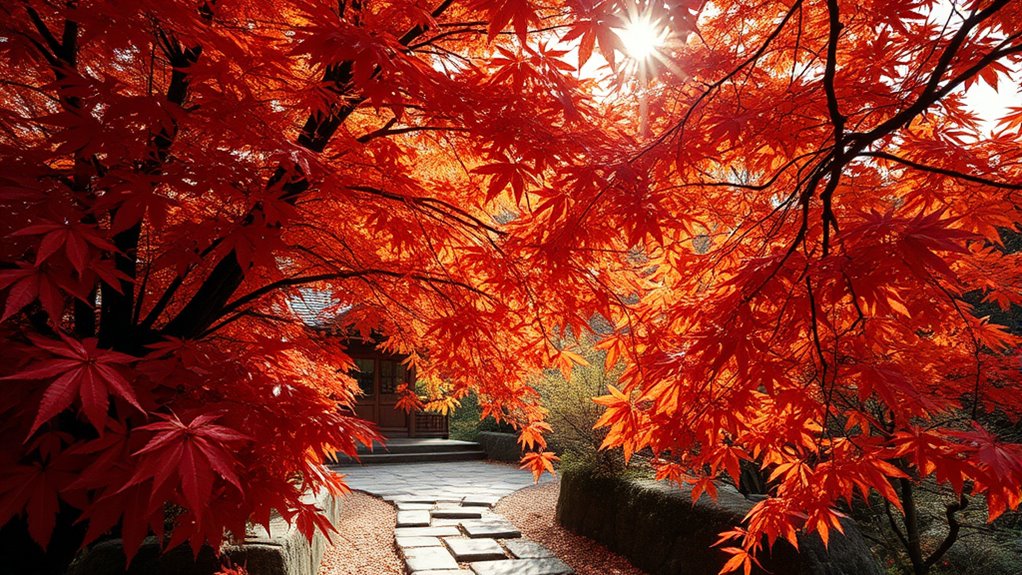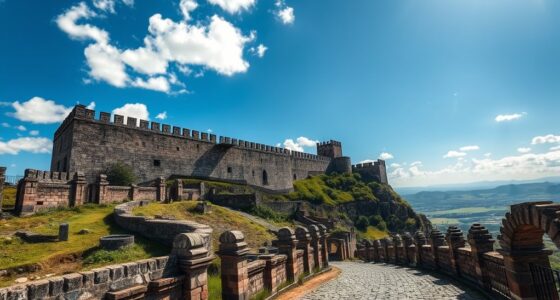Momijigari is Japan’s beloved tradition of enjoying the vibrant autumn leaves, dating back to the Heian period. You’ll find it celebrated in historic temples, scenic mountain spots, and cities with colorful festivals and night illuminations. As the foliage peak shifts with climate and location, many travelers explore diverse sites for the best views. If you’re curious about its cultural roots, seasonal timing, or modern innovations, you’ll discover fascinating details ahead.
Key Takeaways
- Momijigari is a traditional Japanese practice of viewing and appreciating colorful autumn leaves, dating back to the Heian period.
- It symbolizes the transient beauty of nature, emphasizing impermanence and aesthetic appreciation through seasonal change.
- Popular destinations include Kyoto temples, Hokkaido parks, and mountain passes, often celebrated with festivals and illumination events.
- Climate variability influences peak foliage times, prompting modern tools like apps and virtual tours to enhance visitor experience.
- The tradition supports ecological conservation, boosts tourism, and continues evolving through modern innovations while preserving cultural significance.
Origins and Historical Development of Momijigari
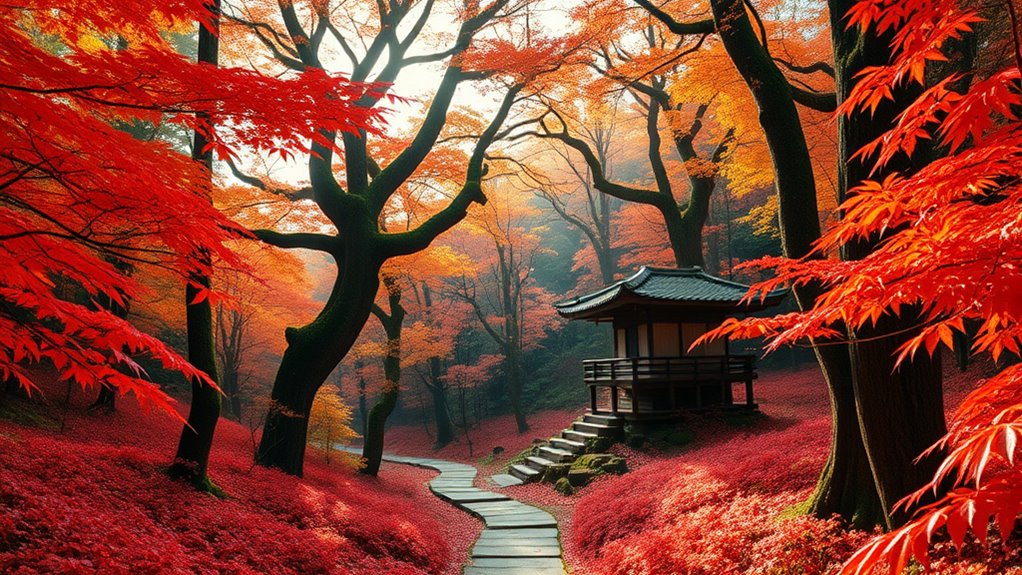
Momijigari originated during the Heian period (794–1185) as an elegant social activity primarily among aristocrats. Its folklore origins link to the appreciation of seasonal symbolism, especially the vibrant red and yellow leaves of autumn. Originally, “Momiji” referred to all deciduous leaves changing color, derived from a verb connected to plant dyeing, emphasizing the beauty of nature’s transformation. The term “gari,” once associated with animal hunting, became a refined euphemism for seeking seasonal plants and leaves, highlighting the activity’s cultural sophistication. During this time, aristocrats visited forests and gardens, holding banquets and composing poetry, blending nature observation with arts and reflection. This tradition reflected an appreciation of impermanence, laying the foundation for the deep spiritual and aesthetic significance that would develop in later periods. In modern times, foraging practices have expanded beyond aristocratic circles to include the general public, fostering a broader appreciation of natural beauty and sustainability.
The Timing and Seasonal Changes of Autumn Foliage
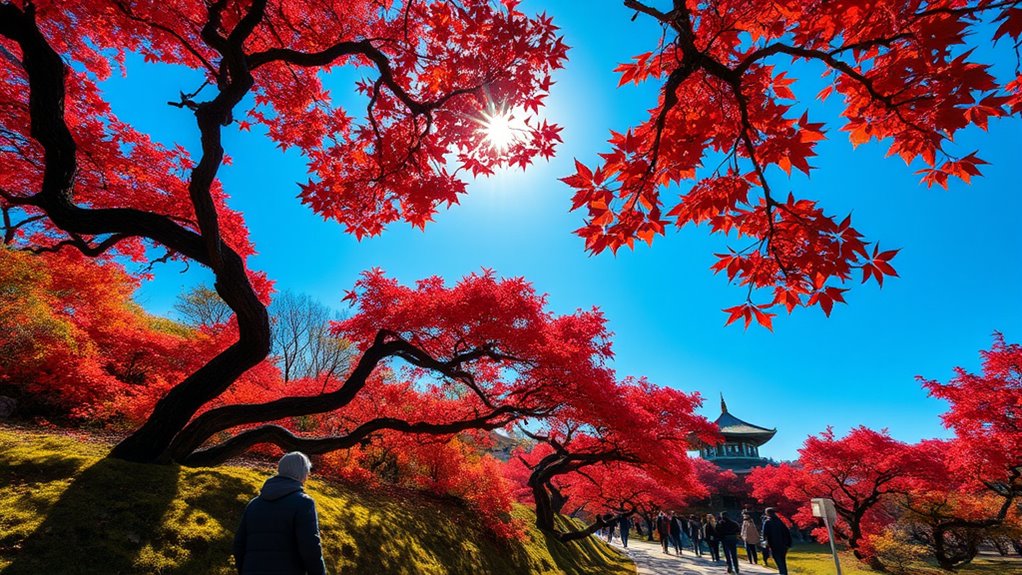
The timing of autumn foliage across Japan varies considerably depending on the region and elevation. Climate variability influences when leaves change color, leading to a seasonal migration of vibrant hues from north to south. In northern high-altitude areas like Hokkaido, peak colors start in late September, while southern regions such as Kyushu see their best from mid-November to early December. Elevated areas tend to change earlier, then move downward as temperatures cool. The table below highlights typical timing:
| Region | Peak Foliage Period | Notable Locations |
|---|---|---|
| Hokkaido | Late September – October | Daisetsuzan, Shiretoko |
| Tohoku | October – November | Hakkoda, Oirase Gorge |
| Central Japan | October – November | Japanese Alps, Fuji Five Lakes |
| Southern Japan | November – December | Kyushu, Shikoku |
These patterns shift yearly due to climate variability, impacting the seasonal migration of colorful leaves. Understanding climate patterns helps predict the timing for optimal viewing each year.
Cultural Significance and Aesthetic Appreciation
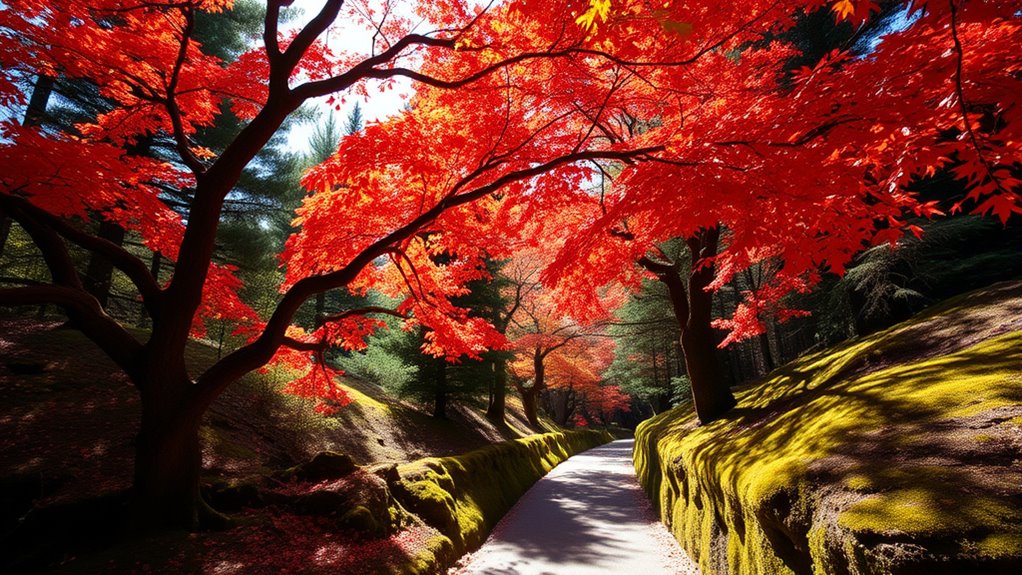
Rooted in Japan’s cultural history, the practice of autumn leaf viewing embodies more than just appreciating nature’s changing colors; it reflects deep philosophical and aesthetic values. The vibrant hues of momiji symbolize impermanence and fleeting beauty, embodying the concept of *wabi-sabi*. This appreciation encourages you to reflect on life’s transient nature and find beauty in impermanence. The colorful leaves serve as powerful cultural symbols, inspiring poets and artists to capture their melancholic elegance in literature, paintings, and crafts. These visual motifs evoke emotional depth and seasonal awareness, enriching Japan’s artistic traditions. Momijigari’s symbolism and imagery foster a profound connection between nature and culture, inspiring ongoing creative expression and reinforcing the importance of harmony, impermanence, and renewal. Additionally, the seasonal change in foliage is celebrated through various traditional festivals and rituals, which further deepen the cultural significance of momijigari as a communal activity. Recognizing the seasonal change in foliage enhances understanding of Japan’s deep-rooted appreciation for natural cycles and their influence on cultural practices.
Popular Destinations and Traditional Practices
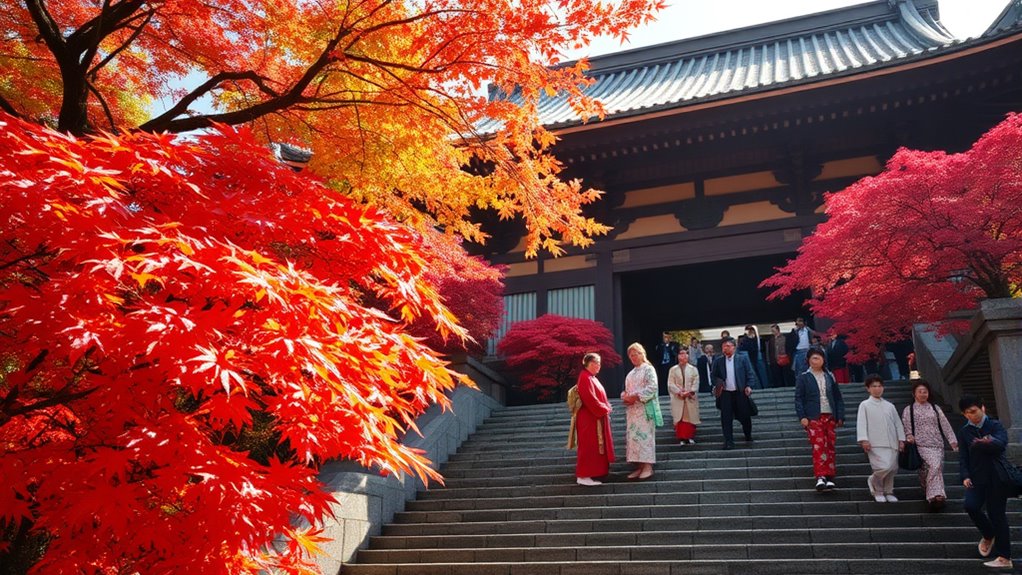
You can experience the vibrant beauty of autumn by visiting renowned destinations across Japan, where traditional practices enhance the seasonal appeal. Popular spots like Kyoto, with its historic temples such as Kiyomizu-dera and Tōfuku-ji, showcase stunning leaf color displays that reflect Japan’s cultural heritage. In Hokkaido’s Daisetsuzan National Park, vast landscapes burst with vibrant koyo from late September, offering a natural spectacle. During momijigari, you actively hunt for the best foliage, often exploring temple gardens and scenic mountain passes. Many locations host seasonal festivals and light-up events that celebrate the changing colors, creating a festive atmosphere. These destinations often feature easy access by public transport and accommodations designed to accommodate visitors, ensuring you can fully enjoy this traditional autumn activity. Additionally, incorporating rustic decor and natural elements can enhance your experience by connecting you more deeply with the seasonal landscape.
The Economic Impact of Autumn Leaf Viewing
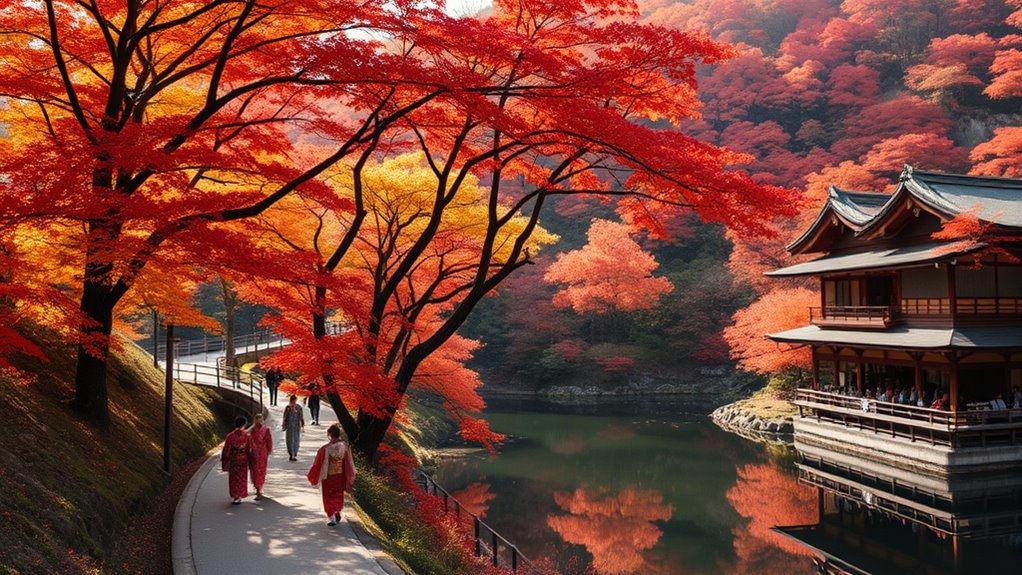
Autumn leaf viewing, or koyo, considerably boosts Japan’s tourism revenue by attracting millions of visitors annually. This seasonal surge fills hotels, restaurants, transportation, and souvenir shops, generating billions of yen and supporting local economies. However, economic disruptions can occur if peak foliage timing shifts due to climate change, leading to reduced visitor numbers and lost income. Regions relying on predictable autumn tourism face economic uncertainty as warmer autumns cause delays and irregular colors, disrupting schedules and marketing efforts. Businesses must adapt through climate adaptation strategies, promoting alternative activities like winter festivals or cultural events to offset potential revenue declines. Overall, the seasonal nature of momijigari makes Japan’s tourism industry sensitive to environmental changes, emphasizing the importance of flexible planning to sustain economic stability. Additionally, the unpredictability of foliage timing complicates planning for both local businesses and tourists, further emphasizing the need for adaptive strategies. Developing flexible marketing campaigns can help attract visitors even when peak foliage varies unexpectedly.
Botanical Aspects and Environmental Significance
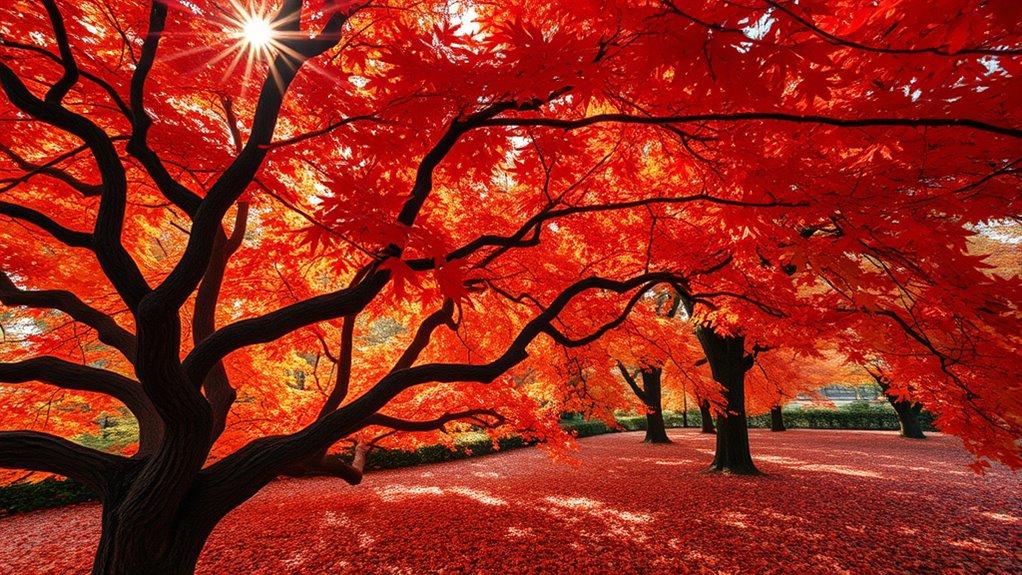
The botanical characteristics of momiji, particularly the Japanese maple (*Acer palmatum*), play a central role in its striking autumn display. Its palmate leaves contain vibrant leaf pigments like anthocyanins, which produce the intense reds, while carotenoids add yellows and golds. This combination contributes to the rich foliage diversity seen during fall. As daylight hours decrease and temperatures cool, chlorophyll breaks down, revealing these underlying pigments and creating the season’s signature colors. The process of pigment change is influenced by environmental factors such as temperature and sunlight, which further enhances the vividness of the leaves. Healthy environmental conditions, including soil and moisture, influence the intensity and timing of leaf color change. Additionally, ecological functions like nutrient recycling rely on the natural shedding process of these leaves, supporting the health of forest ecosystems. Preserving diverse deciduous forests ensures the continued beauty and ecological importance of autumn foliage, making momijigari a celebration of both nature’s artistry and environmental balance.
Modern Trends and the Future of Momijigari
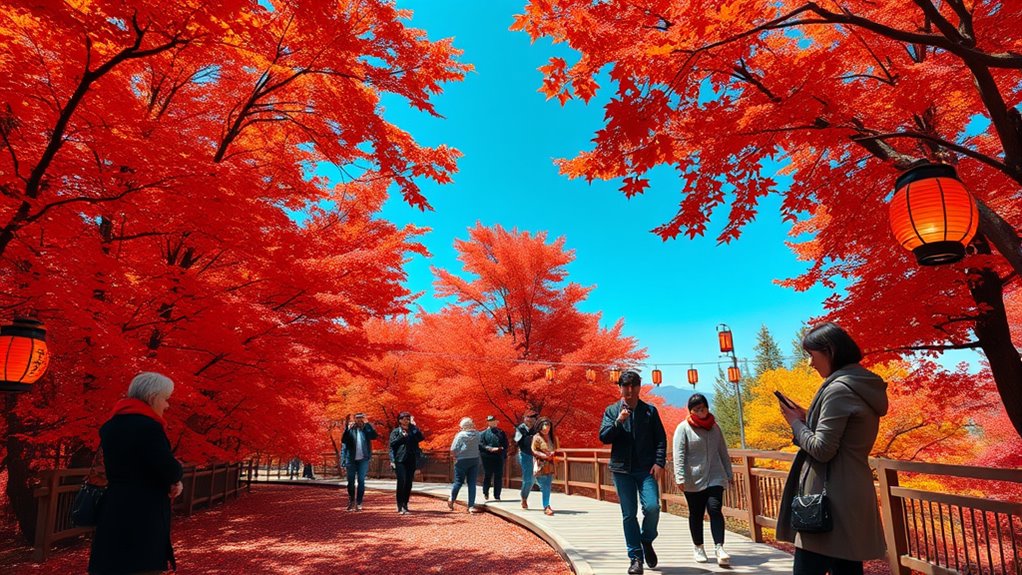
Modern trends are transforming momijigari into more accessible and immersive experiences. Urban adaptation plays a key role, as city-based sites and seasonal events make leaf viewing easier for residents and visitors alike. Technological integration enhances planning and participation through tools like fall foliage forecasting technology, mobile apps, and interactive maps that provide real-time updates on peak leaf colors and best viewing spots. Virtual reality and augmented reality experiences are emerging, allowing people to enjoy momijigari virtually or supplement their visits. Guided photography tours and cultural experiences, such as tea ceremonies paired with momiji-themed sweets, deepen engagement. Social media and online platforms also promote lesser-known locations, broadening the tradition’s reach. Additionally, shelf life of related products is considered when offering local specialties during the season, ensuring freshness and quality for visitors. These innovations are shaping momijigari’s future, blending tradition with modern convenience and technology.
Frequently Asked Questions
How Has Urbanization Affected Traditional Momijigari Practices?
Urban sprawl has considerably altered traditional practices by limiting access to natural viewing spots and increasing infrastructure that encroaches on forests and mountains. You might find fewer remote locations for leaf viewing, pushing you toward urban parks or organized events. While urbanization challenges cultural preservation, efforts like planting momiji trees and urban initiatives help maintain the tradition. Still, the authentic experience of observing autumn leaves in natural settings diminishes as cities grow.
Are There Specific Japanese Festivals Associated With Autumn Leaf Viewing?
You’ll find that Japan hosts several autumn festivals linked to leaf viewing customs. These festivals, like the one at Nara’s Tanzan Shrine or Kyoto’s Arashiyama, celebrate the vibrant fall foliage with traditional music, poetry, and boat rides. They highlight Japan’s deep appreciation for nature’s seasonal beauty, blending cultural practices with scenic enjoyment. Participating in these autumn festivals allows you to experience the rich traditions that make leaf viewing a cherished part of Japanese culture.
What Are the Environmental Impacts of Increased Momijigari Tourism?
You might think tourism only benefits local economies, but it also causes wildlife disturbance and trail erosion. As crowds flock to view autumn leaves, their footsteps compact soil and damage plants, disrupting wildlife habitats. Over time, erosion worsens, threatening trees and natural beauty. While tourism brings joy, it’s essential to balance it with efforts to protect ecosystems, ensuring future generations can enjoy the vibrant scenery without harm.
How Do Regional Differences Influence Momijigari Experiences Across Japan?
You’ll notice that regional differences shape your momijigari experience across Japan. In northern areas, cooler climates bring earlier, more vibrant foliage, while central regions offer diverse colors and cultural symbolism in temples and gardens. Southern spots have milder hues and unique regional cuisine like chestnuts. These variations influence your outdoor activities, blending natural beauty with local cultural practices, making each region’s momijigari uniquely memorable.
What Are Some Eco-Friendly Ways to Enjoy Momijigari Sustainably?
Remember, “leave no trace,” as you enjoy responsible leaf peeping. You can practice eco-conscious travel by taking public transportation and sticking to designated trails. Use reusable containers, avoid collecting leaves, and share your experience responsibly on social media. Supporting local conservation efforts and choosing off-peak times helps reduce environmental impact. By being mindful, you guarantee future generations can also appreciate the beauty of autumn’s fleeting moments.
Conclusion
As you embrace momijigari, you join a tradition enjoyed by millions—over 50 million visitors flock to Japan’s autumn sites each year. This vibrant practice connects you to centuries of cultural appreciation and natural beauty, reminding you of nature’s fleeting, precious moments. Whether you’re admiring the fiery red leaves or supporting local economies, you’re part of a cherished seasonal celebration that beautifully blends history, art, and environmental harmony.
